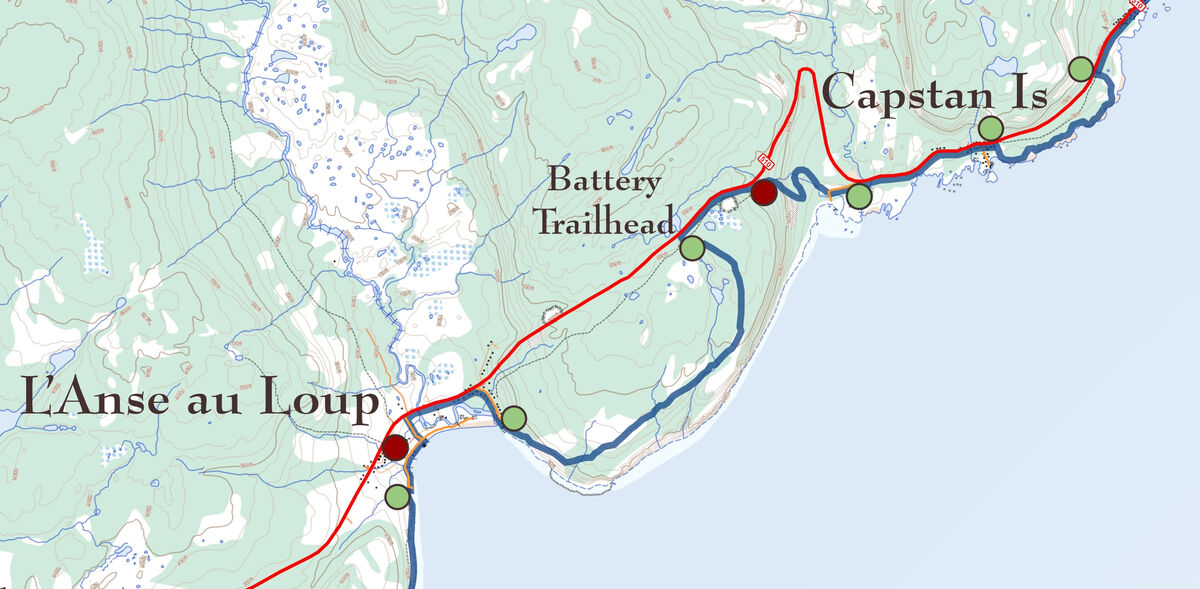L'Anse au Loup to Pinware
Arrive L'Anse au Loup
The trail from Point Amour arrives on the western shore of L'Anse au Loup harbour and joins with a community road. Hikers can follow the road through town and around to the far side of the cove where the trail continues onward.
Town of L'Anse au Loup
L'Anse au Loup is the largest town in the Labrador Straits region and is one of only a few rural towns in the province of Newfoundland and Labrador that still has a growing population. L'Anse au Loup is a French name meaning "Wolf Cove", but the name may have less to do with the animal, Canis Lupis, and perhaps more to do with "Loup Marin" - a term the French used as a reference to seals. Although L'Anse Au Loup was first established by the French in the early 1700's, it was later settled by English, Scots and Irish.
Today, the economic mainstay of the region is still the fishery and the spin-off jobs that derive from it. The region's economic flagship is the Labrador Fishermen's Union Shrimp Company Limited, one of the most modern fish processing facilities in the province.
Schooner Cove
Schooner Cove, and all of L'Anse au Loup, has a very rich history. At least five prehistoric sites have been uncovered at Schooner Cove spanning 8,000 years of occupation.
Basque whalers and fishermen lived and worked in Schooner Cove seasonally for decades in the mid 16th century. Up until 1763, 2 or 3 French fishing ships, with crews of between 75 and 100 men, operated out of Schooner Cove and L'Anse au Loup each season.
Shortly after the 1763 treaty that ceded New France to England, fish merchants from the southwest of England arrived on the scene in Labrador. The firm of John Noble and Andrew Pinson established. A base in Schooner Cove. The premises remained operational until the late 1920s when the final owner, Job & Brothers of St. John's, eventually closed its doors at Schooner Cove forever.
From L'Anse au Loup to the Battery
A Walker's Perspective: from L'Anse au Loup to the Battery
Text to come...
From the Battery to Pinware
A Walker's Perspective: from the Battery to Pinware
Text to come...
Town of Capstan Island
Capstan Island is a small fishing community with a rocky coastline. It is not actually an island but got its name from a small tidal island off shore, where in 1851, the residents constructed a capstan, a sturdy wooden post and handle, mounted in a stabilizing frame, used to wind-in a rope or cable. The capstan pulled a line attached to the door of a seal net, or trap, that stretched to the mainland capturing seals on their spring migration. Capstan Island has excellent garden soil. The region's only commercial greenhouse is located here.
Town of West St Modeste
In the early 1700s, Pierre Constantin gave his fishing concession the title of "Seigneurie du Grand St Modet" The Devon-based firm of Noble and Pinson established a sealing post at West St Modeste and a salmon post at Pinware as early as 1774. Around 1800, Grand and Petit St. Modet became East and West St Modeste, each designating the village at the extremes of St Modet Bay. Dr. Wilfred Grenfell opened the second co-op store in Labrador in West St Modeste in 1903.
Town of Pinware
text to come...






